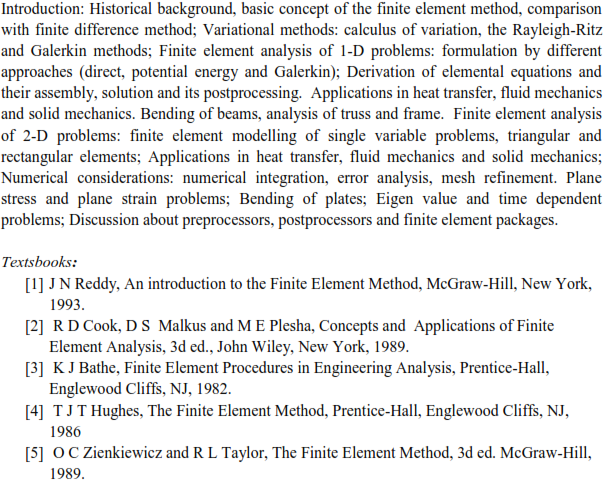
M Tech (Computational Mechanics)
SEMESTER-I
|
Course No. |
Course Name |
L |
T |
P |
C |
|
ME 501 |
Advanced Engineering Mathematics |
3 |
0 |
0 |
6 |
|
ME 532 |
Finite Element Methods in Engineering |
3 |
0 |
0 |
6 |
|
ME543 |
Computational Fluid Dynamics |
3 |
0 |
0 |
6 |
|
ME 502 |
Engineering Computing Laboratory |
0 |
0 |
3 |
3 |
|
ME xxx |
Elective – I |
3 |
0 |
0 |
6 |
|
ME xxx |
Elective – II |
3 |
0 |
0 |
6 |
|
|
15 |
0 |
3 |
33 |
|
SEMESTER-II
|
Course No. |
Course Name |
L |
T |
P |
C |
|
ME541 |
Continuum Mechanics |
3 |
0 |
0 |
6 |
|
ME542 |
Numerical Analysis |
2 |
0 |
2 |
6 |
|
ME544 |
Computational Mechanics Laboratory |
0 |
0 |
2 |
2 |
|
ME xxx |
Elective – III |
3 |
0 |
0 |
6 |
|
ME xxx |
Elective – IV |
3 |
0 |
0 |
6 |
|
ME xxx |
Elective – V |
3 |
0 |
0 |
6 |
|
|
15 |
0 |
0 |
32 |
|
SEMESTER-III
|
Course No. |
Course Name |
L |
T |
P |
C |
|
ME 503 |
Technical Writing |
1 |
0 |
2 |
4 |
|
ME 504 |
Project Phase I |
0 |
0 |
20 |
20 |
|
|
1 |
0 |
22 |
24 |
|
SEMESTER-IV
|
Course No. |
Course Name |
L |
T |
P |
C |
|
ME 505 |
Project Phase II |
0 |
0 |
24 |
24 |
|
|
0 |
0 |
24 |
24 |
|
ME 541 Continuum Mechanics
Introduction to Tensors: Vectors and second order tensors; Tensor operation; Properties of tensors; Invariants, eigenvalues and eigenvectors of second order tensors; Tensor fields; Differentiation of tensors; Divergence, Stokes and Localization theorems.; Kinematics of Deformation: Continuum hypothesis; Deformation mapping; Material (Lagrangian) and Spatial (Eulerian) field descriptions; Length, area and volume elements in deformed configuration; Material and spatial time derivatives - velocity and acceleration; Linearized kinematics; Balance Laws: Conservation of mass; Balance of linear and angular momentum - Cauchy stress tensor, state of stress; Spatial and material forms of balance laws - concept of first and second Piola-Kirchoff stress tensors; Conservation of energy; Continuum Thermodynamics: Basic laws of thermodynamics; Energy equation; Entropy; Clausius-Duhem inequality. Constitutive Equations: Material frame-indifference; Objective stress and stress-rates; Material symmetry; Constitutive relations for Hyperelastic Solids, Generalized Hooke's law; Simple fluids; Navier-Stokes equation.
Texts/References:
ME 542 Numerical Analysis
Introduction to numerical analysis, Significant digits, Types of errors; Stability; Accuracy; Solutions of Linear Algebraic Equations: Direct elimination methods, Pitfalls of elimination methods, Norm and condition number; Iterative methods, Accuracy and convergence of iterative methods; Solution of Eigenvalue Problems; Solutions of Nonlinear Equations: Newton’s method, System of nonlinear equations, Convergence and Error analysis; Interpolation: Lagrange polynomials, Divided difference polynomials, Hermite and cubic spline interpolation, Least square approximation; Numerical Differentiation – Unequally spaced data and Equally spaced data, Error estimation and extrapolation; Numerical quadrature – Newton-Cotes, Gauss quadrature, Multiple integrals; Initial and boundary value problems – Classification of ODEs, One step methods, Convergence and numerical stability analysis, Solution of higher order equations, Multistep methods, Convergence and stability analysis.
Laboratory component : The lab is intended to be a platform for students to get used to scientific computing. Strong emphasis is laid on computer programming and the student is expected to write his own programs/codes for prototypical mathematical problems which will have real--life applications in the area of computational mechanics.
Texts/References:
ME 543 Computational Fluid Dynamics
Basic equations of Fluid Dynamics: General form of a conservation law; Equation of mass conservation; Conservation law of momentum; Conservation equation of energy. The dynamic levels of approximation. Mathematical nature of PDEs and flow equations. Basic Discretization techniques: Finite Difference Method (FDM); Analysis and Application of Numerical Schemes: Consistency; Stability; Convergence; Fourier or von Neumann stability analysis; Modified equation; Application of FDM to wave, Heat, Laplace and Burgers equations. Integration methods for systems of ODEs: Linear multi-step methods; Predictor-corrector schemes; ADI methods; The Runge-Kutta schemes. Vorticity-stream function formulation. Solution of Navier-Stokes equations using MAC algorithm. The Finite Volume Method (FVM) and conservative discretization. Numerical solution of the incompressible Navier-Stokes equations: Primitive variable formulation; Pressure correction techniques like SIMPLE, SIMPLER and SIMPLEC; Brief introduction to compressible flows and numerical schemes – quick idea of Euler equations, homogenity and flux jacobian. Introduction to upwind schemes.
Texts/References:
ME 544 Computational Mechanics Lab
Introduction to Ansys modules including general steps for solving a problem. Simple mesh generation for one-dimensional or two-dimensional domain; Using appropriate commercial package: A simple 2-D heat conduction problem. Heat convection in a heated cavity. A problem from bluff body flows/shear flows; Using appropriate commercial package: One dimensional problem: A cantilevered beam/simply supported beam with distributed load/concentrated load. An I-beam under distributed/concentrated load. A two dimensional problem: plate under tensile loading. Truss, closed cylinder under pressure.
ME 532 Finite Element Methods in Engineering

--00--